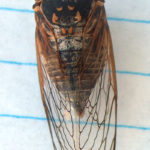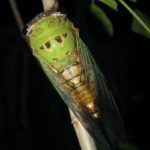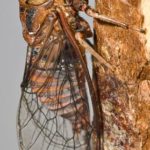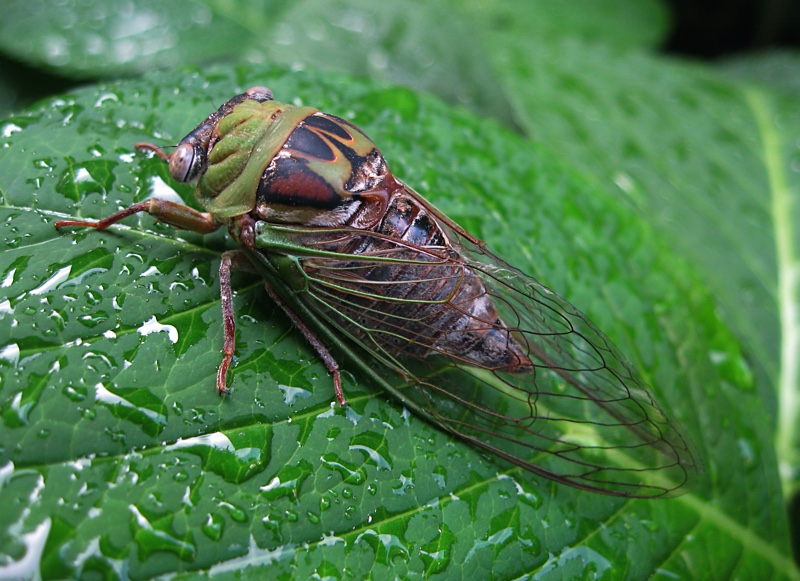I admire your website and love it!!! Here in Brazil we see lots of cicadas everyday.
I posted here the link to my blog, where i do post every picture i take from cicadas here in Brazil. If i see a different cicada, a take several pics (and sometimes a videoshoot) and make a very detailed record of its features, including the song.
I wish you could publish the link to my blog (sorry but it’s in portuguese, but people can comment in english).
thanck you!!!
Comment by Franco — December 19, 2010 [AT] 9:50 am
Finally the big ones are out with loads of ‘red eyes’ (see Flickr) and green grocers/ morphs along the coast and around Canberra (around 10 species). A trip in western NSW over 4 days netted 22 species (4 new) and expanded distributions of many rarer ones. We have been collecting flannel flower seeds for a PhD project in november/december and found quite a few cicadas in the safaris. I hope to post some to Dan shortly, including the lovely 10mm Urabunana sericeivitta from Gosford, where we also found black princes, yellowbellies, double drummers, Pauropsaltas annulata and fuscata, and a Cicadetta ticker.
Although the larger ones are making plenty of noise, there are only small emergences of little species around Sydney.
Comment by David Emery — December 13, 2010 [AT] 7:38 pm
Hello all,
With the current Cold front from up north, (Highs in the 50s and lows in the 30s), I think I have heard the last one a week ago for this year. It does get very cold — Freezing — in south florida.
Joe
Comment by Joe Green — December 8, 2010 [AT] 3:07 pm
Keep up the nice work David, and Joe, you are probably are one of the very few state-siders that still hears the cicada’s call. All insects here are pretty much gone. We wait patiently for northern spring!
Comment by Elias — November 28, 2010 [AT] 8:20 pm
Moderate emergences continue down under as the crazy wet/dry events keeep them low. Some hot waether last week heralded green grocers singing around Sydney (emerging around 2 weeks late). A 4-day run through western NSW yielded around 20 species (mostly 20mm body length) and linked distributions of speciemns from nothern and more southern areas. the species that seems to have benefitted from all the rain and grass growth is Cicadetta waterhousei that appears widespread in November. The Black Princes have emerged last week as well, so perhaps the larger species will follow in numbers. It’s not much of a season so far around Sydney and it’s raining again!
Comment by David Emery — November 28, 2010 [AT] 1:45 pm
Hello all,
Sorry for the long hiatus, but haven’t been doing much cicada work lately but wanted to let north americans know that Tibicen davisi’s are still calling in south florida, west of Miami, fla. Seem’s I heard more males today than last week calling from pine tree’s.
Great to read post’s about what’s happening down under, keep them coming.
Joe Green
Comment by Joe Green — November 17, 2010 [AT] 5:47 pm
Hi Naomi,
Probably you have a darker “yellow monday” that is pretty rare amongst colours of the GGs. As for the Aussie emergence around Sydney, the erratic cold and wet season has played havoc with the October species that have barely surfaced. ones that have, such as small squeakers and masked devil versions of the GGs have been silenced by the repeated rain. Some hot weather last weekend saw the double drummers coming out of their holes around 0830h in the morning and emerging on fences and trees en masse at Hawks Nest (like 4 years ago!). hope for some better finds in the next 2 weeks.
Comment by David E — November 15, 2010 [AT] 3:07 am
Hi. We have recently found an orange cicada that i think is a ‘red devil’. Are these rare? as i am used to seeing only the green grocer’s in victoria australia
Comment by Naomi — October 29, 2010 [AT] 12:51 pm
OK, the Aussie summer is underway with the first green grocers singing around western Sydney last night (12th October). One emerging GG was also posted on Flickr. The local bladder cicada population has reached at least 25 males and the smart large black and white birds (currawongs)are hanging about at dusk to catch the females flying in to the singing males. I have also heard 4 other species, but it is early days and more should emerge once this thunderstorm front moves through over the next 2 days.
Comment by David E — October 13, 2010 [AT] 2:50 am
Hello David,
Love the picture of the bladder cicada! Please send more pictures of other species! Dead quiet here in NY. I am going to follow the Australian cicadas now!!
Take care
Elias
Comment by Elias — September 17, 2010 [AT] 3:45 pm
No Elias- Lindsay’s is the best.
Comment by David Emery — September 12, 2010 [AT] 7:15 pm
Hello David. Found this site with the calls of Australian cicadas and pictures. http://sci-s03.bacs.uq.edu.au/ins-info/index.htm
Do you have any other sites to learn about these fascianting species?
Comment by Elias — September 12, 2010 [AT] 4:29 pm
The early guys are emerging in Sydney. Bladder cicadas (Cystosoma saundersi)and Cicadetta celis (silver princess) were heard on Sept 10.
Comment by David Emery — September 12, 2010 [AT] 3:43 pm
I have a captive T. davisi that is doing quite well in captivity. Today is day #16. The record is held by a captive T. auletes lasting 23 days in captivity. Wonder what the longest length of time a cicada has been kept in captivity?
Comment by Elias — September 12, 2010 [AT] 6:23 am
Hello David,
Time to turn the spotlight onto the Southern Hemisphere!!
New York has fallen silent. Northern cicada-maniacs will live vicariously through you.
-Elias
Comment by Elias — September 11, 2010 [AT] 9:09 am
Move aside all of you dying Tibicens– bladder cicadas are emerging down under for the start of the orchestral entertainment in the southern hemisphere!!
Comment by David E — September 7, 2010 [AT] 4:28 am
Sounds like a Tibicen tibicen aka chloromera aka Swamp Cicada.
Comment by Dan — August 28, 2010 [AT] 5:20 pm
I’ve run across a few very large, very loud cicadas in the St.George area of South Carolina in the last few days. (Southeast corner of intersection of I-26 and I-95). They are mostly black, with a little white on top with white bellies. As big as my thumb. I captured one in a jar this evening — frightening — and the dog is going crazy for them. The hundreds in the trees join into a wave of noise every few minutes.
Comment by Dimitri — August 28, 2010 [AT] 5:13 pm
Its Day 3 for the male Tibicen canicularis I have in captivity. It produced a week alarm squawk yesterday. Will see how long it can be kept alive.
Comment by Elias — August 23, 2010 [AT] 3:54 am
That is a Tibicen cicada.
Comment by Dan — August 19, 2010 [AT] 6:22 pm
Here is a link to pictures of what my husband and I think is a Cicada. We live in New York State. Does anyone know if this is actually a Cicada?
Comment by Sally B — August 19, 2010 [AT] 6:08 pm
Here in New York Tibicen linnei and Tibicen chloromera are still going strong. My captive auletes died 23 days post emergence. Another observation is that the Cicada killers appear to be finished early as no more adult females were seen by the lek in a nearby park. Not to long left to the Northern cicada season!
Comment by Elias — August 16, 2010 [AT] 3:58 am
Aug 14, 6:30pm. We are having a large swarm flying Round our yard now(50-100) south of Rock Falls, IL.
Comment by Kim — August 14, 2010 [AT] 4:56 pm
Hello Steve,
Great to see your shared enthusiasm for this remarkable insect. T. auletes is my favorite species. IF you can find a male eclosing and rear it in captivity, it will provide you with tons of entertainment. Have one that is 15 days old now.
Caught some stragglers from Brood II last year. Only Magicicada septendecim. I believe cassini and septendecula may be mixed in.
I am going to travel to see Brood XIX. It would be my first contact with the thirteen year species.
Comment by Elias — August 6, 2010 [AT] 3:28 pm
Elias, our main species here in eastern Kansas and Western Missouri are T.Pruinosa, T.Walkeri and T. Auletes. I have heard T.Chloromera and T.Canicularis and we have quite a few T.Dorsatus in the open areas around here.
I’m curious to see what happens with brood XIX next year as we are to have a decent brood right up to western Missouri, pretty close to Kansas City. We had an emergence of about 15-20 Periodicals in early June this year which were from brood IV due here in 2015. It was a rather large number as far as stragglers go. They were all in a small area as well. They were M. Cassini’s so maybe we will see an early emergence here. Should be interesting to say the least. I will try and take some pictures if we get a decent number of Tibicen emerging again tonight. My kids are fascinated with them and I guess I am too 😉
Comment by Steve — August 6, 2010 [AT] 7:14 am
Nice job Steve! We here in the North East never get to see such large #’s of cicadas except (Periodical Cicada emergences). What other species do you have by you? Kansas is particularly blessed. Here is a great paper on the biology of Kansas cicadas. http://entnemdept.ufl.edu/walker/buzz/c700lb28.pdf
Comment by Elias — August 6, 2010 [AT] 3:50 am
Got home from school tonight and found no less than 17 emerging Tibicen on 2 trees in my back yard. Looks like about ten of them are Tibicen Marginalis(Walkeri)several Tibicen Pruinosus and 2 Tibicen Auletes. The last 3 nights here in Kansas City have been pretty incredible. Averaging about 10-20 a night. Have a good mix of the 3 species singing right in the backyard each day and evening.
Comment by Steve — August 5, 2010 [AT] 8:25 pm
257 Comments
Went light collecting in New Jersey again — recovered 3 T. lyricen females. 88 degrees F (31 deg C) yesterday at night. No neocicada or auletes. First auletes eclosing was recovered 7/22. That was a beautiful sight. Waited many years to see that!!
Comment by Elias — July 25, 2010 [AT] 6:49 am
Went to Lakewood NJ yesterday. The light hunting technique finally worked! Captured 2 Neocicada hieroglyphica and 1 Tibicen lyricen male that flew to a ground based bright lighting system. Temperature was around 80 degrees (F) (27 deg C). Heard a fast tempo T. auletes call which was much faster than the others that called at the usual slow tempo. Also heard Tibicen chloromera, a species I never heard in the pine barrens before.
Comment by Elias — July 18, 2010 [AT] 6:21 am
Yes Joe — Still have to catch my 1st nymph!! have a bunch of days off so will have some fun now! Good luck down in FL.
Comment by Elias — July 16, 2010 [AT] 8:03 pm
JULY,
is cicada season, all over the USA, It seems they started to call early due to the hot weather and dry conditions here.
joe
Comment by Joe Green — July 15, 2010 [AT] 4:06 pm
Hello all,
Cicada season has started in NY. Heard Tibicen lyricen and Tibicen chloromera calling. No exuvia found yet. Last year it was July 14th that I found the first nymph and a little later before I actually heard one.
Great to hear from you Joe — will let you know when I make it down to West Palm. Hopefully will do it soon!!
Comment by Dan — July 2, 2010 [AT] 5:54 pm
Elias,
So far D. viridifascia has been diffacult to catch, most are high up in tree’s to carch. Some that sound low, they seem to shut-up when approched which makes for a quik get away before I spot him.
Let me know if or when your in west palm — July and Augest is good months here.
Comment by Joe Green — July 2, 2010 [AT] 1:33 pm
I live near Nashville and recall a HUGE emergence in 1994 (maybe 1995??), but can’t seem to find any record of it and that year doesn’t fit the published brood cycles. Anyone else with me on that?
Comment by CKintheMJ — July 2, 2010 [AT] 12:05 pm
Hello Joe,
At some point have to get down to West Palm. I have heard diceroprocta viridifascia and olympusa last year. Never saw a live specimen or exuvia/nymph.
I have a week off coming in June — will have to do an Okanagana expedition then. Will keep you posted. Cant believe cicada season is here already! Felt like it snuck up on me!
Elias
Comment by Elias — June 3, 2010 [AT] 4:36 am
Elis,
I hear more when I travel inland from the coastlal region (Western side of Florida heading toward Lake Okachobee. More hieroglyphica’s, the most I can recall ever here In the city limits this early. Time to begin hunting and good luck on those Okanagana’s, keep us posted .
Joe
Comment by Joe Green — June 1, 2010 [AT] 3:35 pm
Hello Joe,
Watched your video. Firmly cements D. olympusa’s call in my brain. Have to start getting stuff together for some hunts this year. Hoping to see/catch Okanagana this year. I know the feeling about work — so tired from this weekend but got a 5 day Memorial Day vacation coming up!
Comment by Elias — May 24, 2010 [AT] 7:15 pm
Elias,
I can only assume that the abundant calls on N. hieroglyphica means its a good year for cicada’s, more than previous years. This weekend while working I heard Dicroprocta olympusa calling in Lehigh Acres, florida from pine tree’s. So I think, I’ll get my gear ready to collect some 2010 specimens, however I’m getting tired of work spoiling my weekend hunts like this weekend.
Comment by Joe Green — May 24, 2010 [AT] 4:06 pm
Hello Joe,
Yes — did hear them in July in central NJ. Do they go to lights too? That may be my one chance to get them. The summer was so cold last year that light collecting produced 2 T. chloromera, 1 T. lyricen and 1 T. auletes (first specimen). If Spring helps predict summer this should be good. Will keep you thoroughly updated. It was nice hearing cicada calls so early in Florida.
Comment by Elias — May 24, 2010 [AT] 12:42 am
Elis,
Keep looking and listning around your area, june — August would be a good time to search in your area. I’d say the best calling time is mid day to evening the hottest part of the day, even though thay call from Dawn to Dusk, this is the time period I hear more of them calling. I’ve noticed that at chico’s today not many were calling at 2:00pm, I wonder if the males have mated with females and died off???
Comment by Joe Green — May 22, 2010 [AT] 5:09 pm
Hello Joe,
Specimens of Neocicada have been reported at the eastern end of Long Island about 100 years ago. Need to get out there this June and confirm those data points. Would be very interesting if i can find them!!
Comment by Elias — May 22, 2010 [AT] 2:34 pm
Elias,
I’m glad you have them that far north, Sanborn says thay range to that area north and as far west as Arkansas/Texas south down into mexico. Remember the one’s you heard in orlando are varation johanns, and those in New jersey are N. hieroglyphica regular species here in the US. I don’t know any spacific’s but they sound the same in calling song.
Hopefuly we can communica more later.
Joe
Comment by Joe Green — May 19, 2010 [AT] 4:53 pm
Thank you Joe for your thorough and informative response. I have located neocicada in mid New Jersey. Also Davis places there most Northern range at the end of Long Island. I will have to invstigate this year. I hope to capture a specimen from NJ in addition to getting some more Auletes. Cant seem to get enough of that species!!
Comment by Elias — May 18, 2010 [AT] 1:17 pm
Hello Mark,
The Percey Prist Lake area is a good place to find cicada’s, lots of land and parks. Glad to hear there are stragglers 1-year early in that area as I’ll be there next year for the big explosion next year in 2011. Its the great 13 year brood that I’ll be conducting work in Georgia, Alabama, Tenneessee and maybe the Carolina’s. I understand that there are large locations located in sections of those states. Most magicicada’s have a resting period before heading to the tree’s for mateing higher up, some of them like to conduct business down low however.
joe
Comment by Joe Green — May 17, 2010 [AT] 5:49 pm
Hello Elias,
Neo hieroglyphica shells and nymph’s are small, they are a medium sized cicada when they turn to adults. Only when I get lucky do I find a nymph only on a tree. They have a uncanny ability to know when you are there, because I find them stopped on the tree (Not moving like Tibicen’s or magicada’s do when approched) not knowing if they are anchored for molt, I not the place & tree, then come back in a few minutes only to find the nymph has move farther up the tree, and yes its stopped not moving when I spot him. I find them mostely in the molting process and just a magicicada’s (White) they are easy to spot neocicada (Light green). I have found molting one’s in the morning, noon, evening and dusk but more of them at dusk time just before it gets dark. Exuvia-you must look close on the tree’s, I’ve found their molts on grass, sticks laying on the ground, base’s of the trunks of tree’s to as high up as 10 feet high in the tree. Best thing i can say is take your time when looking, I’ve found more on the ground than on trees. As far as catching them goes, I’ve had more fun with a net because sometime’s you have to figure out how to position the net in the best way to capture the adult cicada if there’s not to many limbs, leaves or stuff to do so. Otherwise you must dislodge the cicada from the present perch to a new location if you can follow the flight path. Maybe you can catch him. If you find large aggrations of calling males it is possable to catch them by hand without a net if they are low to the ground, otherwise your going to need a good pair of Binocolars to spot them on the limbs.
Joe
Comment by Joe Green — May 17, 2010 [AT] 5:20 pm
Heard Neocicada hieroglyphica call in the trees in the back parking lot of the Hilton Hotel on Buena Vista drive, Orlando, Florida. I was unable to locate exuvia or nymphs. Probably Joe Green would be the best equipped to answer this question — what is the best way to capture an adult specimen in addition to nymphs/exuvia?
Comment by Elias — May 14, 2010 [AT] 9:49 pm
Went out to feed the birds and noticed cicada shells everywhere. As I looked down I saw them in the grass also. Upon closer inspection I saw the insects and they appear to be the Magicicada that I have seen posted. There were dozens just sitting everywhere.. so I guess they are drying out. We live in the Priest Lake area of Nashville.
Comment by Mark — May 12, 2010 [AT] 6:08 am
Since 4/24/2010 there has been a incress in numbers of Neocicada hieroglyphia’s here in south florida. I have been keeping a emergance log of this species for 6 years now and they uselly start out slow and I don’t heard large numbers until June. This week, large groups (Dozens) calling from Oak tree’s at work. My friends are also reporting hearing them from other parts of the area. I’m going to a few sites to check out whats happening with my camera and camrecorder ready.
Thanks, Joe
Comment by Joe Green — May 9, 2010 [AT] 7:00 am
We’ve seen a few today in Brentwood, TN — – YUCK
Comment by erin — May 8, 2010 [AT] 1:32 pm
Randall, the ones that are out now are stragglers, emerging a year early. If you like, submit your sighting to magicicada.org and they’ll put it on their map.
Comment by Dan — May 8, 2010 [AT] 9:47 am
in Nashville. We noted this weekend the emergence of what appears to be 13-year cicada. I have lived here for the last two emergence in 1985 and 1998.
They are not due again till 2011! Isn’t this about a year and a month early?
We have had a recent flood (15 inches in two days) last weekend. Would that cause an early emergence?
Comment by Randall — May 8, 2010 [AT] 9:05 am
I know it is late in the season, are cicadas still active in Australia?
Comment by Elias — March 30, 2010 [AT] 9:06 am
Hi Helen,
It IS a great year for the big cicadas around NSW except for the riverina. If rain holds off, they should start diminishing by late January. They ARE excellent perch (bass) bait, although the “crazy crawler” lures that flop across the surface like cicadas are sure-fire as well.
David
Comment by David E — January 11, 2010 [AT] 7:40 pm
Do you know where can I purchase some cicadas? Please send me any information that you can to my email directly. Thank you for your help in advance.
Fred
fsharp [AT] egacc.com
Comment by Fred — January 11, 2010 [AT] 3:05 am





















